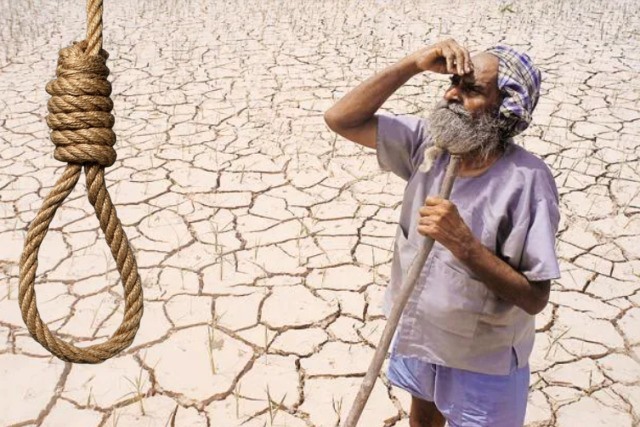Understanding farmer suicides requires a deep examination of their underlying causes, particularly in the context of Maharashtra. In 1990, The Hindu newspaper’s rural editor, P. Sainath, reported on the frequent suicides of farmers. Initially, reports of farmer suicides emerged from Maharashtra. Soon, similar incidents were reported from Andhra Pradesh. It was initially believed that most suicides were committed by cotton farmers in Maharashtra’s Vidarbha region. However, statistics from Maharashtra’s State Crime Records Bureau in 2010 revealed that the suicide rate was alarmingly high among farmers growing various cash crops across the state. The suicides were not limited to small farmers but included medium and large-scale farmers as well.
To investigate this crisis, the state government formed several inquiry committees. Then-Prime Minister Manmohan Singh announced a ₹110 billion relief package for farmers in Vidarbha. Over time, due to the agricultural crisis, farmer suicides were also reported in Karnataka, Kerala, Andhra Pradesh, Punjab, Madhya Pradesh, and Chhattisgarh. In this context, the National Crime Records Bureau (NCRB) recorded 17,368 farmer suicides in 2009, with Maharashtra, Karnataka, Andhra Pradesh, Madhya Pradesh, and Chhattisgarh accounting for 10,765 (62%) of these cases.
In Maharashtra, between January 1 and December 31, 2024, 2,706 farmers from Vidarbha and Marathwada committed suicide. This was confirmed by the state’s Relief and Rehabilitation Minister, Makarand Patil, in a written response to a starred question in the Legislative Assembly. The Amaravati division recorded 1,069 suicides, while the Chhatrapati Sambhajinagar division saw 952 suicides, primarily due to climate change, droughts, crop failures, and debt. Of these 2,706 cases, 1,563 were deemed eligible for government aid. In 101 cases, the farmers’ families received ₹30,000 through direct financial assistance and ₹70,000 from the bank’s monthly income scheme, totaling ₹100,000 in aid.
Data from the past decade indicates that Maharashtra sees an average of 3,000 farmer suicides annually. In 2020, 2,270 farmers committed suicide. Information obtained under the Right to Information (RTI) Act from the State Relief and Rehabilitation Department confirms these figures. However, while releasing these statistics, the department claimed that suicides had declined in all divisions except Nagpur and Nashik. Vidarbha remains the region most associated with farmer suicides.
Despite government compensation for bereaved families, there has been little focus on addressing the root causes of these suicides. In reality, a significant portion of Vidarbha’s population relies entirely on agriculture for survival, with no alternative livelihood options. Moreover, since 91% of agriculture in the region is rainfed, any monsoon unpredictability directly affects farmers’ livelihoods. However, the crisis in Vidarbha is not just due to monsoon dependence but also results from government policies, rising costs, and political neglect of farmers’ issues.
The lack of reliable lending institutions in Vidarbha forces many farmers to depend on private moneylenders for financial support. Additionally, the crisis is linked to erratic rainfall and the high cost of cultivating cash crops like cotton. Last year, farmers who grew Kharif crops suffered losses of up to 60%, severely impacting their financial stability and their ability to invest in the next farming cycle.
Financial Burden on Cotton Farmers
Vidarbha, especially Yavatmal district, is known for cotton production. However, like other districts in the region, Yavatmal has been in the news for decades due to farmer suicides. Farmers continue to cultivate their land year after year despite the ongoing crisis, hoping for a successful harvest.
A key question is: how much does a cotton farmer in Vidarbha spend per acre in pursuit of a good yield? Their work begins with land leveling, followed by debris removal, purchasing seeds, fertilizers, and pesticides, hiring labor, sowing, irrigating crops at the right intervals, and grading cotton once harvested. After all these efforts, when a farmer finally brings his cotton to market, he often struggles to get a fair price.
Due to delays in government procurement, many farmers have had to sell their cotton to traders at prices ranging from ₹5,300 to ₹5,400 per quintal. Cotton farming is the most common practice among Kharif season farmers, and many report spending around ₹36,000 per acre on cultivation. The approximate breakdown of costs includes:
Land leveling: ₹1,000 ,Debris removal: ₹500
Seeds: ₹750,Sowing: ₹1000,Fertilizers: ₹5,000
Herbicides: ₹5,000,Pesticides: ₹5,000
Irrigation: ₹10,000,Cotton grading: ₹4,000
Transportation: ₹2,000,Security: ₹1,000
Unpredictable weather continues to pose a significant threat, and farming costs are rising. Despite this, farmers persist with their work because they have no alternative. However, every time they invest heavily in cultivation, unexpected rainfall often destroys their crops, leading to substantial financial losses. Consequently, they are trapped in an ever-growing cycle of debt.
State government data from the past two years highlights that most farmer suicides in this period occurred in the Amaravati division, with 1,893 recorded cases. Yavatmal district reported the highest number of suicides (295). The Aurangabad division ranked second, with 1,528 suicides in two years, followed by Nashik and Nagpur, where the number of suicides increased compared to 2019. Over two years, these regions recorded 774 and 456 suicides, respectively.
The state’s Relief and Rehabilitation Department attributed the reported decline in suicides in 2020 to the government’s debt waiver program, which provided financial relief to farmers. Additionally, the government granted concessions on land revenue and electricity bills in cases of natural disasters.
Indian agriculture remains heavily dependent on monsoons, and crop failures due to erratic rainfall are a major driver of farmer suicides. Droughts, rising costs, and mounting debts create a cycle of distress, trapping farmers in a web of banks, moneylenders, and middlemen. One of the primary reasons for farmer suicides is the lack of profitability in farming, making it increasingly unviable as a livelihood.
One critical issue is the shrinking size of agricultural land holdings. In 1960-61, the average landholding size was 2.3 hectares, which dropped to 1.6 hectares in 2002-03. While rural households’ income has increased, so have their expenses and debt burdens.
The National Bank for Agriculture and Rural Development (NABARD) conducted the All India Rural Financial Inclusion Survey (NAFIS) 2021-22, which analyzed post-COVID economic conditions based on data from 100,000 rural households. The findings revealed that the average landholding of farmers had declined from 1.08 hectares in 2016-17 to just 0.74 hectares in 2021-22, a 31% drop in five years.
Meanwhile, farmers’ monthly household income increased from ₹8,059 in 2016-17 to ₹12,698 in 2021-22, a 57.6% rise. However, household expenses also grew from ₹6,646 to ₹11,262 per month, marking a 69.4% increase. The proportion of expenditure on food declined from 51% to 47%, indicating that rural families are now spending more on non-food items, raising concerns about food security.
At the same time, debt levels have risen. The percentage of rural households in debt increased from 47.4% to 52%, reflecting economic strain. Institutional borrowing rose from 60.5% to 75.5%, with a significant increase in the use of Kisan Credit Cards (KCC), which expanded from 10.5% in 2016-17 to 44.1% in 2021-22.
Since economic liberalization, agricultural practices, especially cash crop farming, have changed significantly. Due to socio-economic hardships, many farmers lack technical knowledge about high-investment cash crops like Bt cotton. This financial strain makes them more vulnerable to debt and, ultimately, suicide. Addressing this crisis requires comprehensive policy reforms that prioritize financial security, sustainable farming practices, and support for struggling farmers.
The writer can be reached at vikasmeshram04@gmail.com


